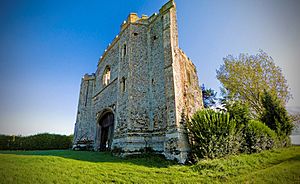Pentney Priory facts for kids
Pentney Priory was a special kind of monastery called an Augustinian priory. It was located in a village called Pentney in Norfolk, England. Today, you can still see the old gatehouse, which is made of flint stone. This gatehouse is a very important historical building, known as a Grade I listed building.
How It Started
Pentney Priory was founded around the year 1130 by a person named Robert II de Vaux of Pentney. It was dedicated to three important figures: the Holy Trinity, the Blessed Virgin Mary, and Mary Magdalene.
Later, in 1468, a church leader named Walter Hart, who was the Bishop of Norwich, decided to join Pentney Priory with another priory called Wormegay Priory. This meant that Wormegay Priory became a smaller part, or "cell," of Pentney Priory.
The End of the Priory
Pentney Priory eventually closed down in 1537. This happened during a time called the Dissolution of the Monasteries, when King Henry VIII decided to close many monasteries across England. The person in charge of Pentney Priory at that time, Prior Codde, received a regular payment (a pension) of £24. He was also given a new job, becoming the warden (or manager) of the Hospital of St Giles in Norwich, which was a place that cared for sick or poor people.
After the priory closed, its land and buildings were given to Thomas Manners, 1st Earl of Rutland in 1538 or 1539. Over time, the priory site became part of a place called Abbey Farm. Stones from the old priory were even used to build parts of Abbey Farm and other buildings in the village of Pentney.
Keeping History Alive
In 2012, a group called English Heritage gave £200,000 to help fix the old priory gatehouse. The stone walls were starting to crumble, so this money was used for important repairs to keep the historic building safe and standing for future generations.


